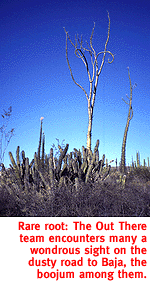
In The Baja, The Tentacled Giants Await--Part 2 of 3.
By Kevin Franklin
"BOOJUM--DEAD AHEAD!" I chirp into the C.B. Like
a 30-foot-long unfurling tentacle of some submerged gargantuan
squid, a mid-size boojum breaks the horizon of the Baja desert.
 After we spy the first specimen, dozens reveal themselves from
the gravely soil.
After we spy the first specimen, dozens reveal themselves from
the gravely soil.
People describe boojums as looking like giant hairy carrots or
fantastically twisted telephone poles covered in spikes. The Cochimí
Indians of Baja called them milapá, but with the
introduction of the Jesuit missions, most of those Indians died
off from a host of European diseases--thanks for the blessing,
Padre.
Having little nomenclature competition, the Mexicans took to
calling them cirios, Spanish for the tall candles which
they sometimes resemble, write Jeanette Coyle and Norman Roberts
in A Field Guide To The Common And Interesting Plants Of Baja
California.
The name "boojum" comes from the first gringo scientist
to describe them, Godfrey Sykes. In 1922, Sykes was exploring
the deserts of Mexico when he spotted these curious plants through
his telescope. Having read The Hunting of the Snark
and Lewis Carroll's reference to a boojum as a "mythical
thing found in desolate far-off regions," Sykes called out
"Ho, ho, a boojum, definitely a boojum!" writes Robert
Humphrey in The Boojum And Its Home.
While not exactly mythical, boojums are found only in the Vizcaíno
Desert of Baja and a small section of mainland Mexico near Libertad,
Sonora. Boojums frequently reach a height of 60 feet, and I know
of one topping out over 86-feet high. The trunks often contort
into spindly curves and twists. When a half dozen arms follow
suit, it makes for a plant that appears more likely to come from
a child's finger-painting class than the Mexican desert.
 Boojums are related to ocotillos, and, upon close inspection,
the "hairy" part of the hairy carrot description turns
out to be small, sometimes leafy tiny ocotillos.
Boojums are related to ocotillos, and, upon close inspection,
the "hairy" part of the hairy carrot description turns
out to be small, sometimes leafy tiny ocotillos.
Our two-truck caravan is traversing the west coast of Baja
south of El Rosario, and we'll be in boojum country for the rest
of our trip. Intermixed with the boojums are cardóns,
which look like saguaros on steroids. There are no saguaros in
Baja, and a close look reveals the cardóns are taller
and more massive than saguaros and have fewer pleats in their
trunks and arms.
Through this forest of exotic plants, we make our way from
the Baja Highway 44 miles south of El Rosario toward the Pacific
beach and a fish camp called Puerto Catarina.
Puerto Catarina served as a seaport for an onyx mine and
village called El Marmol 50 miles inland. The onyx was shipped
to Tijuana to be fabricated into bookends, chessmen and other
tourist kitsch. Many an onyx elephant migrated through this hot,
dusty valley on its way to a Michigan coffee table. The mine has
long since ceased operation, and the road deteriorated, but according
to Tom Miller's The Baja Book, you can still see the action
of the soda springs alongside an arroyo forming onyx near the
now-abandoned village.
However, we are ocean-bound and headed in the opposite direction.
The first half of the 40 miles of road is in good condition. This
gets us to Santa Catarina, a small inland hamlet. Two miles farther
south, the road forks. The right fork heads more directly to the
beach and we follow that. The track soon becomes rocky and steep,
but not too much of a challenge for a decent four-wheel drive.
After three hours of dirt road and a dusty playa, we reach the
beach.
A half-dozen ponga boats dot the windy beach. A lone fisherman
sorts through his gear as we approach. He directs us to a good
campsite a half mile down the beach at the base of a fresh-water
estuary.
There are dunes here that protect us from the wind, and the estuary
is a magnet for birds. Moorhens, mallards, grebes and a heron
work the murky water for their evening meals.
Later in the evening, a pack of coyotes surrounds us from a distance
for a soulful evening howl. It's a strange serenade, but a fitting
one for this place of exotic plants and onyx elephants.

|
